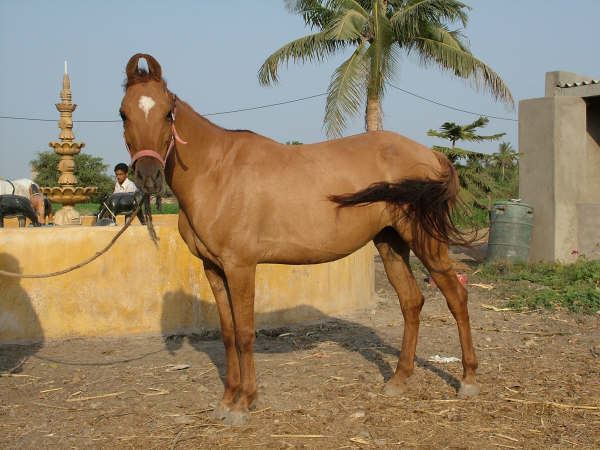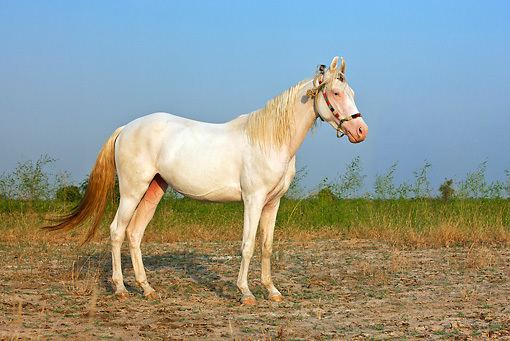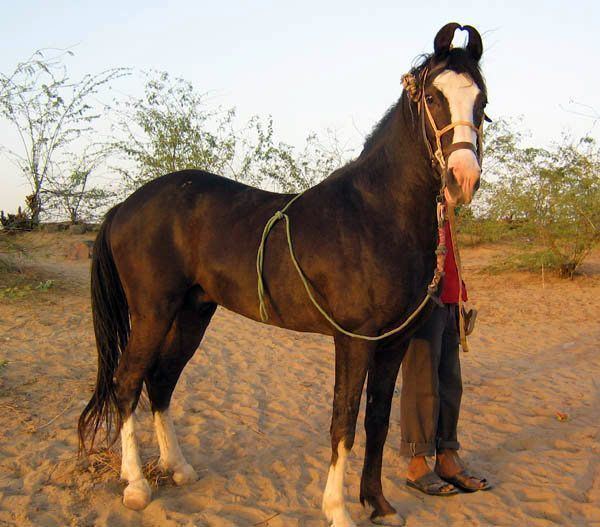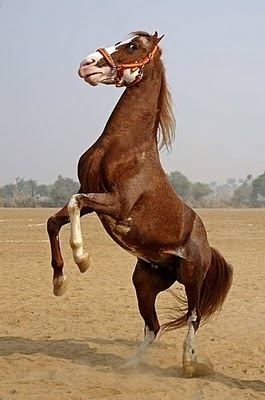Country of origin India Higher classification Horse | Rank Breed | |
 | ||
Conservation status FAO (2007): not at risk Other names KathiawadiGujarati: કાઠીયાવાડીKathiCutchiKutchi Use ridingdrivingpolice mountsports Weight Male: 325 kgFemale: 275 kg Similar Marwari horse, Iomud, Barb horse, Kabarda horse, AraAppaloosa | ||
Kathiawari horse horse picture collection
The Kathiawari or Kathiawadi (Gujarati: કાઠીયાવાડી) is a breed of horse from the Kathiawar peninsula in western India. It is associated with the Kathi people of that area. It was originally bred as a desert war horse for use over long distances, in rough terrain, on minimal rations. It is closely related to the Marwari horses of Rajasthan; both breeds have been influenced by imported Arab horses. It is found in all colours except for black, and is most commonly chestnut. Numbers diminished after Indian independence, and today there are few Kathiawaris left. In the past it was used as a war horse and as a cavalry mount. Today it is used for riding, in harness and for sports; it may be used as a police horse and for the sport of tent-pegging. A breed register is kept by the Kathiawari Horse Breeders' Association, which also organises annual shows.
Contents

Characteristics

The average height at the withers is 147 cm (14.2 hands). Height should not be more than about 152 cm (15 h); taller horses may seem coarse.:161 The breed is found in all colours except for black. Chestnut is the most common colour, followed by bay, grey and dun. Dun horses may have primitive markings, a dorsal stripe and zebra stripes on the legs. Skewbald patterns do exist, but are extremely rare. The Kathiawari has a concave facial profile, with a broad forehead and short muzzle. The neck and body are proportional and relatively short, while both the head and tail are carried high. Although well-proportioned, many Western breeders consider them to be lacking in bone in the legs. However, soundness is an inherent characteristic of the breed. One of the breed's most distinctive features is its ears, which curve inward to touch and sometimes overlap at the tips. The Kathiawari has the most extremely curved ears of any breed of horse. At some points in the breed's history, breeders focused on the preservation of these curving ears, to the detriment of some other, more important, physical characteristics. Like many desert breeds, the Kathiawari can subsist on minimal rations and water and is more resistant to the heat than breeds developed in colder climates. As well as the usual gaits, the Kathiawari also performs a swift, lateral pace, called the revaal. They are known as high-spirited, intelligent and affectionate horses.

The Kathiawari is closely related to the Marwari breed from the Marwar region of Rajasthan, which borders with northern Gujarat. Genetic diversity analysis groups the two breeds, while the other four Indian horse breeds – the Bhutia, the Manipuri, the Spiti and the Zaniskari – form a distinct and separate group. The Kathiawari and the Marwari are also phenotypically similar; in particular, they have the same unusual in-curved ears. The Kathiawari is not as tall as the Marwari, and has a smaller thoracic circumference;:53 it is most commonly chestnut, while the Marwari is usually black.:71 Kathiawaris tend to have slight facial differences from the Marwari. The Kathiawari also resembles the Arab horse, which contributed significantly during the development of the breed.
History

The origins of the Kathiawari are unknown. There were indigenous horses on the western coast of India before the arrival in the early sixteenth century of the Turco-Mongol invaders who later established the Mughal Empire.:160 Beginning during the Mughal reign, and continuing during the British Raj, Arab horses were imported to India and crossed with the native stock, creating the ancestors of the modern Kathiawari breed. The Kathiawari may have also been influenced by the Mongolian horse.:196 Traditionally, noble households specialised in their own strain of horses, naming their lines of horses after a foundation mare; 28 of these lines still exist. These noble houses selectively bred horses that could withstand extreme temperatures and minimal rations, carry a man with weapons and armour for long periods in rough terrain, and still be swift and nimble. They bred for wiry, sleek horses that were ideal for war, and Kathiawaris were noted for their loyalty and bravery in battle, often defending their riders even when wounded themselves. This breeding was maintained until the Independence of India.
Although still mainly bred in the Kathiawar peninsula, it is also found in the Maharashtra and Rajasthan states. The Kathiawari Horse Breeders' Association maintains a register. The Gujarat government maintains stud farms in eleven different locations; one in Junagadh holds both mares and stallions and is tasked with preserving the breed, while the other ten hold Kathiawari stallions that are used for improving the local stock of other or mixed breeds. In 2007, only about 50 Kathiawaris were held by private breeders. Today, the Panchaal region is renowned for its Kathiawari horses, often producing the most beautiful horses of the breed.
In 2007 the conservation status of the Kathiawari was listed as "not at risk" by the FAO.:61 No breed numbers have been reported to DAD-IS since 1997, when there were about 7500.
Uses
In the past, the Kathiawari was considered a good cavalry mount. It was used by Maratha cavalry, and later – until the end of the First World War – by the Indian Army.:161:252 In modern times it is used as a riding horse or as a harness horse. Some are used by Indian police forces, sometimes for tent-pegging, to which the Kathiawari is well suited.:161 In 1995, annual breed shows were hosted by the breed association.:161
